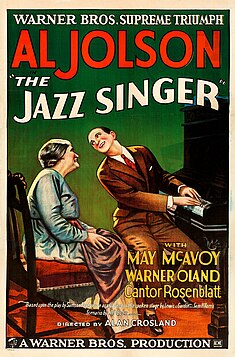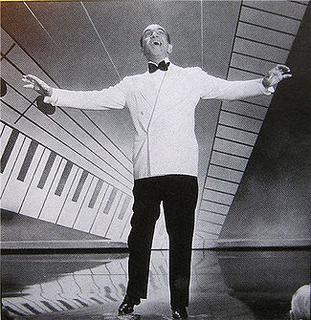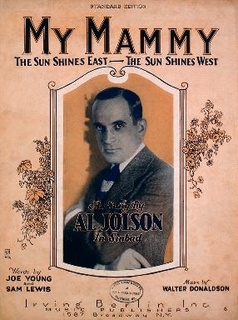
The Jazz Singer is a 1927 American musical drama film directed by Alan Crosland. It is the first feature-length motion picture with both synchronized recorded music score as well as lip-synchronous singing and speech. Its release heralded the commercial ascendance of sound films and effectively marked the end of the silent film era. It was produced by Warner Bros. with the Vitaphone sound-on-disc system and features six songs performed by Al Jolson. Based on the 1925 play of the same title by Samson Raphaelson, the plot was adapted from his short story "The Day of Atonement".

Porky in Wackyland is a 1938 Warner Bros. Looney Tunes animated short film, directed by Bob Clampett. The short was released on September 24, 1938, and stars Porky Pig venturing out to find the last do-do bird, which he finds in Wackyland, a land that makes no sense located in Darkest Africa.

The Jolson Story is a 1946 American musical biography film which purports to tell the life story of singer Al Jolson. It stars Larry Parks as Jolson, Evelyn Keyes as Julie Benson, William Demarest as his manager, Ludwig Donath and Tamara Shayne as his parents, and Scotty Beckett as the young Jolson.
The following is an overview of 1930 in film, including significant events, a list of films released and notable births and deaths.

The Singing Fool is a 1928 American musical drama part-talkie motion picture directed by Lloyd Bacon which was released by Warner Bros. The film stars Al Jolson and is a follow-up to his previous film, The Jazz Singer. It is credited with helping to cement the popularity of American films of both sound and the musical genre.

I Love to Singa is a 1936 Warner Bros. Merrie Melodies animated cartoon directed by Tex Avery. The short was released on July 18, 1936.

Sunday Go to Meetin' Time is a 1936 Warner Bros. Merrie Melodies cartoon directed by Friz Freleng. The short was released on August 8, 1936. The name of the short comes from the colloquial adjective "sunday-go-to-meeting," describing something appropriate for church or otherwise presentable.

Gold Diggers of Broadway is a 1929 American pre-Code musical comedy film directed by Roy Del Ruth and starring Winnie Lightner and Nick Lucas. Distributed by Warner Bros., the film is the second all-talking, all-Technicolor feature-length film.

The Show of Shows is a 1929 American pre-Code musical revue film directed by John G. Adolfi and distributed by Warner Bros. The all-talking Vitaphone production cost $850,000 and was shot almost entirely in Technicolor.

Rose of Washington Square is a 1939 American musical drama film, featuring the already well-known popular song with the same title. Set in 1920s New York City, the film focuses on singer Rose Sargent and her turbulent relationship with con artist Barton DeWitt Clinton, whose criminal activities threaten her professional success in the Ziegfeld Follies.

Sit Tight is a 1931 American Pre-Code musical comedy film, directed by Lloyd Bacon, written by Rex Taylor, edited by James Gibbon, and produced and distributed by Warner Bros. It was originally intended as a full musical, but due to the backlash against musicals, all the songs were cut from the film except for one – sung by Winnie Lightner – in all release prints in the United States.

Manhattan Parade is a 1931 American pre-Code musical comedy film photographed entirely in Technicolor. It was originally intended to be released, in the United States, early in 1931, but was shelved due to public apathy towards musicals. Despite waiting a number of months, the public proved obstinate and the Warner Bros. reluctantly released the film in December 1931 after removing all the music. Since there was no such reactions to musicals outside the United States, the film was released there as a full musical comedy in 1931.

General Crack is a 1929 American pre-Code part-talkie historical costume melodrama with Technicolor sequences which was directed by Alan Crosland and produced and distributed by Warner Bros. It was filmed and premiered in 1929, and released early in 1930. It stars John Barrymore in his first full-length talking feature. The film would prove to be Crosland and Barrymore's last historical epic together. It was based on the 1928 novel General Crack by the British writer Marjorie Bowen, published under the name George Preedy, one of her several pen names.

Say It with Songs is a 1929 American pre-Code musical drama film, directed by Lloyd Bacon and released by Warner Bros. The film stars Al Jolson and Davey Lee and was a follow-up to their previous film, The Singing Fool (1928).

Wonder Bar is a 1934 American pre-Code film adaptation of a Broadway musical of the same name directed by Lloyd Bacon with musical numbers created by Busby Berkeley.

"My Mammy" is an American popular song with music by Walter Donaldson and lyrics by Joe Young and Sam M. Lewis.

Al Jolson was a Lithuanian-American Jewish singer, comedian, actor, and vaudevillian. He was one of the United States' most famous and highest-paid stars of the 1920s, and was self-billed as "The World's Greatest Entertainer." Jolson was known for his "shamelessly sentimental, melodramatic approach" towards performing, as well as for popularizing many of the songs he sang. Jolson has been referred to by modern critics as "the king of blackface performers."
Natural color was a term used in the beginning of film and later on in the 1920s, and early 1930s as a color film process that actually filmed color images, rather than a color tinted or colorized movie. The first natural color processes were in the 1900s and 1910s and were two color additive color processes or red and green missing primary color blue, one additive process of time was Kinemacolor. By the 1920s, subtractive color was mostly in use with such processes as Technicolor, Prizma and Multicolor, but Multicolor was mostly never in use in the late 1920s, Technicolor was mostly in use. The only one who cared to mess with Multicolor was William Fox, probably because Multicolor was more cheaper of a process and at the time in 1929 William Fox was in debt. The difference between additive color and subtractive color were that an additive color film required a special projector that could project two components of film at the same time, a green record and a red record. But additive color didn't required a special projector, the two pieces of film were chemically formed together and was projected in one strip of film.

Big Boy is a 1930 American Pre-Code musical comedy film produced by Warner Bros. The film was directed by Alan Crosland and stars Al Jolson, Claudia Dell, Louise Closser Hale, and Noah Beery. The film is based on the 1925 Broadway hit show of the same name in which Jolson also starred.

September in the Rain is a 1937 Warner Bros. Merrie Melodies cartoon directed by Friz Freleng. The short was released on December 18, 1937.



















